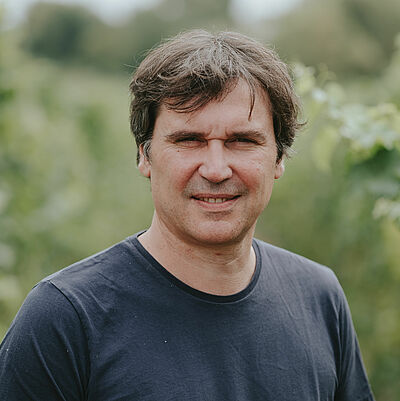
Graduate biologist
Prof. Dr. Jochen Bogs
Professor of Plant Physiology and Viticulture
Bingen Technical University of Applied Sciences
Functions at the Wine Campus
Head of the Dual Bachelor Viticulture & Enology program
Chairman of the examination board
Member of the joint committee of the departments
Teaching areas
- Physiology of the vine and grape
- Biochemistry of the vine and grape
- Biotechnology
- Grapevine breeding
- Grapevine nutrition
Main research areas
1) New resistant grape varieties: defense mechanisms of the grapevine against pathogens
- Investigation of the resistance mechanisms of new, fungus-resistant grape varieties using molecular, biochemical and microscopic analyses.
- Development and testing of combined, holistic plant protection strategies to reduce the use of pesticides in viticulture.
Background and problem definition:
The pathogens of powdery mildew(Erysiphe necator) and downy mildew(Plasmopara viticola) are the most dangerous and economically most important pathogens in viticulture worldwide and can cause total crop failure under optimal climatic conditions. Considerable expenditure on fungicides is therefore necessary in viticulture to prevent damage caused by these pathogens. The consumption of fungicides in viticulture far exceeds that in cereal cultivation or other crops and must be urgently reduced (Eurostat, 2007). One way to reduce the use of fungicides is to increase the cultivation of new, resistant grape varieties (fungus-resistant grape varieties, "Piwis"). However, despite the ecological and economic advantages and the now good wine quality of these new grape varieties, only around 2% of the vineyard area in Germany is planted with Piwi varieties (source: EU vineyard register 2011). The reasons for this very low cultivation area of resistant grape varieties include the still difficult marketing, limited oenological experience and the limited scientific knowledge of the resistance properties of the new varieties and the associated adapted plant protection strategies.
Research and solutions:
The aims of the research projects in the working group are to investigate the genetic differences between different resistant and susceptible grape varieties in order to understand the molecular physiology of successful defense and to identify the relevant genes. At the same time, the stability of the different defense mechanisms against different aggressive isolates of the pathogen will be investigated in order to support the targeted combination of different resistance mechanisms and thus the sustainability of resistance breeding.
At the same time, the potential for saving plant protection products in new, resistant grape varieties is being intensively investigated in field trials with different plant protection variants and resistant grape varieties. The results of these investigations are intended to provide winegrowers with well-founded findings and strategies and thus recommendations for action for sustainable plant protection in resistant grape varieties that sensibly reduce the use of fungicides in viticulture.
2) Grape berry constituents and their influence on grape quality
- Environmental influences (terroir)
- Genetics (varieties) and regulation of metabolic pathways
- Influence of viticultural measures on grape quality
- Development of practical methods and parameters for assessing grape quality
Decisive for the quality of the wine are the value-giving ingredients of the grapes, such as aroma, color and flavor substances, whose content is influenced by environmental influences, viticultural measures and the grape variety. Ongoing research projects are investigating the genetic and environmental influences on the synthesis of colorants and flavorings (flavonoids, stilbenes).
Flavonoids and stilbenes are phenolic ingredients in fruits and plant products such as wine, fruit juices and tea, which contribute significantly to their quality, color, taste and health-promoting effects. Due to their qualitative properties, these substance classes have great potential for the optimization of various plant products such as wine and fruit juices. Current research projects are investigating the genetic basis and the influence of environmental factors and viticultural measures on flavonoid and stilbene biosynthesis. The results of the projects should help to understand flavonoid and stilbene biosynthesis in grapes and thus develop improved vine breeding approaches and adapted cultivation methods that lead to the optimization of the flavonoid and stilbene content in grapes.
